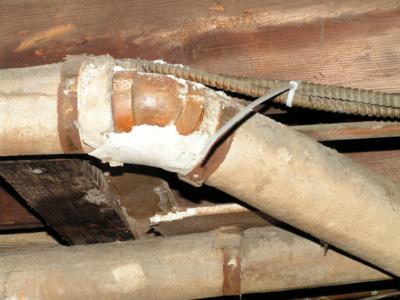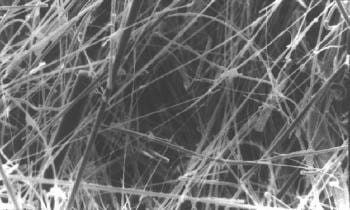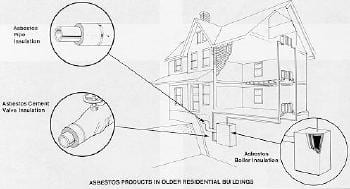
How To Identify Materials That Contain Asbestos
You can’t tell whether a material contains asbestos simply by looking at it, unless it is labeled. If in doubt, treat the material as if it contains asbestos or have it sampled and analyzed by a qualified professional. A professional should take samples for analysis, since a professional knows what to look for, and because there may be an increased health risk if fibers are released. In fact, if done incorrectly, sampling can be more hazardous than leaving the material alone. Taking samples yourself is not recommended. During your Home Inspection our inspectors will inform you if there is a concern for the presence of Asbestos containing materials. All In One Home Inspection LLC is prepared to take Asbestos samples while performing the Home Inspection and have them analyzed at a certified test laboratory.
 What is Asbestos?
What is Asbestos?
Asbestos is a naturally occurring mineral fiber that has been used in more than 3,000 different construction materials and manufactured products. It is commonly found in heating system insulation, decorative spray-on ceiling treatments, vinyl flooring, cement shake siding and a variety of additional materials. Some asbestos-containing materials were still being installed into the late 1980s. All types of asbestos tend to break into very tiny fibers. These individual fibers are so small that many must be identified using a microscope. In fact, some individual fibers may be up to 700 times smaller than a human hair. Because asbestos fibers are so small, once released into the air, they may stay suspended there for hours or even days. Asbestos fibers are also virtually indestructible. They are resistant to chemicals and heat, and they are very stable in the environment. They do not evaporate into air or dissolve in water, and they are not broken down over time. Asbestos is probably the best insulator known to man. Usually asbestos is mixed with other materials to actually form the products. Floor tiles, for example, may contain only a small percentage of asbestos. The asbestos content of different materials varies according to the product and how it is used. Among those materials with higher concentrations of asbestos are insulation products on heating systems and the backing on sheet vinyl flooring. However, an uncontrolled disturbance of any asbestos-containing material in any concentration may be dangerous to your health!
 Why is Asbestos a problem?
Why is Asbestos a problem?
Breathing asbestos fibers can be dangerous. When disturbed, asbestos breaks down into fibers up to 1,200 times thinner than a human hair. When inhaled, they become trapped in lung tissues. Medical research tells us that up to 30 years after inhalation, asbestos fibers can cause lung cancer or mesothelioma, a related terminal cancer of the tissue lining the chest cavity. Because asbestos is a naturally occurring mineral and has been so widely used in manufactured products, including automobile brake linings, it can be found almost everywhere. Trace amounts are in the air we breathe every day. Most of us have asbestos fibers in our lungs. On the other hand, there’s no known safe level of asbestos exposure. That’s why medical, environmental health and regulatory organizations stress the need to protect health by minimizing exposure to airborne asbestos fibers accumulate at elevated levels. Elevated levels result from uncontrolled disturbances and removals of asbestos-containing materials. Asbestos is not always an immediate hazard. In fact, if asbestos can be maintained in good condition, it is recommended that it be left alone and periodic surveillance performed to monitor it’s condition. It’s only when asbestos containing materials are disturbed or the materials become damaged that it becomes a hazard. When the materials become damaged, the fibers separate and may then become airborne. In the asbestos industry, the term ‘friable’ is used to describe asbestos that can be reduced to dust by hand pressure. ‘Non-friable’ means asbestos that is too hard to be reduce to dust by hand. Non-friable materials, such as transite siding and floor tiles are not regulated provided it does not become friable. Machine grinding, sanding and dry-buffing are ways of causing non-friable materials to become friable.
 Where is Asbestos found in my home?
Where is Asbestos found in my home?
Most products made today do not contain asbestos. Those few products made which still contain asbestos that could be inhaled are required to be labeled as such. However, until the 1970s, many types of building products and insulation materials used in homes contained asbestos. Common products that might have contained asbestos in the past, and conditions which may release fibers, include:
STEAM PIPES, BOILERS, and FURNACE DUCTS insulated with an asbestos blanket or asbestos paper tape. These materials may release asbestos fibers if damaged, repaired, or removed improperly.
RESILIENT FLOOR TILES (vinyl asbestos, asphalt, and rubber), the backing on VINYL SHEET FLOORING, and ADHESIVES used for installing floor tile. Sanding tiles can release fibers. So may scraping or sanding the backing of sheet flooring during removal.
CEMENT SHEET, MILLBOARD, and PAPER used as insulation around furnaces and wood burning stoves. Repairing or removing appliances may release asbestos fibers. So may cutting, tearing, sanding, drilling, or sawing insulation.
DOOR GASKETS in furnaces, wood stoves, and coal stoves. Worn seals can release asbestos fibers during use.
SOUNDPROOFING OR DECORATIVE MATERIAL sprayed on walls and ceilings. Loose, crumbly, or water-damaged material may release fibers. So will sanding, drilling, or scraping the material.
ATCHING AND JOINT COMPOUNDS for walls and ceilings, and TEXTURED PAINTS. Sanding, scraping, or drilling these surfaces may release asbestos.
ASBESTOS CEMENT ROOFING, SHINGLES, and SIDING. These products are not likely to release asbestos fibers unless sawed, dilled, or cut.
ARTIFICIAL ASHES AND EMBERS sold for use in gas-fired fireplaces. Also, other older household products such as FIREPROOF GLOVES, STOVE-TOP PADS, IRONING BOARD COVERS, and certain HAIRDRYERS. AUTOMOBILE BRAKE PADS AND LININGS, CLUTCH FACINGS, and GASKETS.
How concerned should I be?
According to the Environmental Protection Agency, the Consumer Product Safety Commission, and the American Lung Association, “the best thing to do with asbestos materials in good condition is to leave them alone. Disturbing it may create a health hazard where none existed before”. Naturally, asbestos materials first need to be identified, evaluated and determined to be in GOOD CONDITION by a qualified asbestos professional before leaving it alone. So, if the asbestos is in good condition and stable, your risk on health effects is relatively low. However, if the asbestos is damaged, there are three things seem to determine your likelihood of developing one of these asbestos related diseases:
The amount and duration of exposure – the more you are exposed to asbestos and the more fibers that enter your body, the more likely you are to develop asbestos related problems. While there is no “safe level” of asbestos exposure, people who are exposed more frequently over a long period of time are more at risk.
Whether or not you smoke – if you smoke and you have been exposed to asbestos, you are far more likely to develop lung cancer than someone who does not smoke and who has not been exposed to asbestos. If you work with asbestos or have been exposed to it, the first thing you should do to reduce your chances of developing cancer is to stop smoking.
Age – cases of mesothelioma have occurred in the children of asbestos workers whose only exposures were from the dust brought home on the clothing of family members who worked with asbestos. The younger people are when they inhale asbestos, the more likely they are to develop mesothelioma. This is why enormous efforts are being made to prevent school children from being exposed.
Because each exposure to asbestos increases the body burden of asbestos fibers, it is very important to reduce and minimize your exposure. Removing or stabilizing the asbestos is the best way to minimize the risk. However, it can be dangerous for the homeowner to do this without proper equipment and skills. The homeowner should be fully informed before trying to address an asbestos problem.
Asbestos Do’s And Don’ts For The Homeowner
DO keep activities to a minimum in any areas having damaged material that may contain asbestos.
DO take every precaution to avoid damaging asbestos material.
DO have removal and major repair done by people trained and qualified in handling asbestos. It is highly recommended that sampling and minor repair also be done by asbestos professionals.
DON’T dust, sweep, or vacuum debris that may contain asbestos.
DON’T saw, sand, scrape, or drill holes in asbestos materials.
DON’T use abrasive pads or brushes on power strippers to strip wax from asbestos flooring. Never use a power stripper on a dry floor.
DON’T sand or try to level asbestos flooring or its backing. When asbestos flooring needs replacing, install new floor covering over it, if possible.
DON’T track material that could contain asbestos through the house. If you cannot avoid walking through the area, have it cleaned with a wet mop. If the material is from a damaged area, or if a large area must be cleaned, call an sbestos professional.